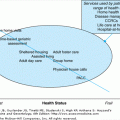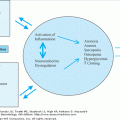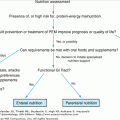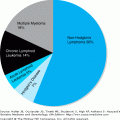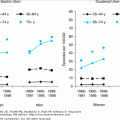Background
“Besides more or less obvious physical changes in old age, physiological investigation may reveal increasing limitation of the effectiveness of homeostatic devices which keep the bodily conditions stable.”
Walter Bradford Cannon (1871–1945)
Elderly patients present the clinician with many unique challenges. Many of these issues are fully discussed in chapters that address care of older adults in the context of individual organ systems and diseases (Chapters 61, 62, 63, 64, 65, 66, 67, 68, 69, 70, 71, 72, 73, 74, 75, 76, 77, 78, 79, 80, 81, 82, 83, 84, 85, 86, 87, 88, 89, 90, 91, 92, 93, 94, 95, 96, 97, 98, 99, 100, 101, 102, 103, 104, 105, 106, 107, 108, 109, 110, 111, 112, 113, 114, 115, 116, 117, 118, 119, 120, 121, 122, 123, 124, 125, 126, 127, 128, 129, and 130). However, some of the most common, debilitating and costly clinical problems seen in geriatrics are extremely challenging because they defy conventional medical wisdom by crossing traditional organ- and discipline-based boundaries. Termed “geriatric syndromes,” conditions such as frailty (Chapter 52), delirium (Chapter 53), falls (Chapter 54), sleep disorders (Chapter 55), dizziness (Chapter 56), syncope (Chapter 57), pressure ulcers (Chapter 58), incontinence (Chapter 59), and elder mistreatment (Chapter 60) are discussed individually. Nevertheless, given the central importance of these diverse conditions to the practice and science of geriatric medicine, it is also important to address their common features.
In addition to being highly prevalent in the frail elderly, geriatric syndromes also exert a substantial impact on quality of life and disability. Moreover, these are complex multifactorial conditions in which large numbers of underlying and provocative risk factors involving different organ systems interact in influencing ultimate clinical presentation, course, and outcome. These unusual features present important challenges for the clinician since the patient’s chief complaint may point away from, rather than toward, the specific pathologic condition, which actually underlies the change in health status. At times, the two processes may involve distinct and distant organs with a disconnect between the site of the underlying insult and the site highlighted by the resulting clinical symptom. For example, when an infection involving the urinary tract precipitates delirium, it is the altered neural function in the form of cognitive and behavioral changes, which permits the diagnosis of delirium and which determines many functional outcomes.
Grouping distinct conditions together as geriatric syndromes also highlights those common features that may help in the development of innovative clinical and research strategies. One of the primary goals of geriatric medicine has been to maintain functional independence in frail older adults, addressing the common paradox of an older patient who is able to maintain usual function under basal conditions, yet decompensates when exposed to seemingly minor challenges. In fact, the clinical dilemma of a frail older adult who is at significant risk of delirium, falls, or incontinence can be restated within a homeostatic framework. Viewed in this manner, function is determined by a complex balance between underlying physiology and health; the nature, number, and intensity of the challenges being experienced, as well as overall physiological plasticity expressed as the effectiveness of relevant homeostatic mechanisms. This approach has several advantages, above all, permitting a collaborative dialogue between investigators conducting more descriptive research and those interested in the study of mechanisms.
Homeostasis in a Historical Context
The term homeostasis was first coined by Claude Bernard in the mid-nineteenth century and is now extensively used in the medical literature. Unfortunately, it is often forgotten that homeostasis has always referred to the body’s attempts at maintaining an internal constancy, which is required for optimal function. Far from reflecting physiologic “stasis,” effective homeostasis actually requires that all relevant compensatory mechanisms remain suitably vibrant, responsive, and well-calibrated. During the twentieth century, it became increasingly clear that overall health status, as well as many individual disease processes may impair an individual’s ability to appropriately respond to common homeostatic challenges. The recognition that aging can also exert a measurable impact on homeostatic mechanisms came later, but is not recent, as illustrated by the 1932 quote preceding this chapter from the great physiologist Walter Cannon. Finally, in the modern era, several events have greatly impacted upon our understanding of homeostasis. In an extension of the concept of homeostasis, Yates has introduced the term homeodynamics to emphasize the concept that the resiliency of living organisms requires a dynamic interplay of multiple regulatory mechanisms rather than a constancy of the internal environment. Advances in basic research have also permitted investigators to explore homeostatic principles at the level of subcellular processes ranging from gene expression to protein turnover. Most recently, some of the limitations inherent in purely reductionist studies have led to a trend toward systems biology, emphasizing an integration of relevant homeostatic processes from the level of individual cells to tissues and organisms. Moreover, it is now possible to begin defining mechanisms in a manner which reflects the multifactorial and systemic nature of typical geriatric conditions or syndromes.
Homeostatic Regulation in Old Age
Physiological systems responsible for maintaining homeostatic regulation may control variables as divergent as body temperature, blood pressure, intracellular calcium, or serum cortisol. At the same time, even among distinct systems, it is possible to observe shared common physiological principles by which they all exert homeostatic control (Table 51-1). With these considerations in mind, a number of investigators have sought to identify unifying and preferably specific “fingerprints” by which aging affects homeostatic control within different physiologic systems.
CONCEPT | EXAMPLES |
|---|---|
Homeostenosis | Diminished capacity to respond to varied homeostatic challenges such as changes in ambient temperature, orthostasis, fluid load or dehydration |
Diminished physiological reserve | Increased homeostatic vulnerability as a result of a critical loss in numbers of neurons or a decline in glomerular filtration rate |
Loss of complexity | Declines in bone or neuronal architecture; narrowing of hearing frequency responses or loss of long-range correlations in blood pressure readings |
Enhanced variability | Greater inter- and intraindividual variability in sympathetic activity or blood pressure readings |
Higher basal activity | Basal sympathetic activity is elevated in older adults |
Excessive response to stressors | Sympathetic responses to common challenges are excessively large and prolonged |
Diminished end-organ responsiveness | Ability of peripheral catecholamines to increase heart rate via β-adrenergic receptors or to mediate arterial vasoconstriction via α-adrenergic receptors is decreased. |
Loss of negative feedback | Ability of corticosteroids to downregulate activity of the hypothalamic-pituitaryadrenal system via negative feedback is diminished |
Allostatic load | Increased biological burden in terms of estimates of cumulative exposure exacted by attempts to adapt to life’s demands predicts future mortality, as well as declines in cognitive and physical function |
Homeostenosis of old age has been viewed as a diminished capacity to respond to various homeostatic challenges. Even healthy older adults may exhibit homeostenosis when exposed to a cold or hot environment, on rapidly assuming the upright posture, and while responding to an acute fluid challenge or hypovolemia. Traditionally, these deficits were attributed to a loss of physiologic reserve, an appealing, yet somewhat ill-defined concept emphasizing static (e.g., losses in neuronal numbers, declines in glomerular filtration rate) rather than dynamic explanations. In an effort to better define physiological factors responsible for the dynamic nature of stability in old age, disease, and frailty, Lipsitz has instead focused on categories of relevant complexity that decline with aging. For example, study of aged bone and brain demonstrates evidence of declining complexity in terms of trabecular or neuronal architecture. Other examples of declining complexity involve physiological processes such as narrowing of auditory frequency responsiveness, decreased long-range correlations in time series data such as blood pressure measurements, as well as increased randomness or stochastic activity in terms of cardiac intervals. It has been proposed that such alterations in dynamics of physiologic systems contribute to functional decline and frailty. However, changes in complexity should not be confused with those involving variability. These are two distinct concepts, with aging often having distinct and at times directly opposite, effects on complexity and variability. For example, aging increases interindividual and intraindividual variability in blood pressure measurements, while long-range correlations involving the complexity of these readings decrease with aging. Finally, proponents of the concept of allostatic load have used population-derived measurements (e.g., blood pressure, waist–hip ratio, cholesterol, glycosylated hemoglobin, cortisol, catecholamines, and DHEA-S) as an estimate of cumulative physiologic burden exacted on the body through attempts to adapt to life’s demands.
In addition to systemic perspectives of homeostasis, there has also been a growing interest in uncovering specific homeostatic mechanisms that are impaired in old age. For example, markers of sympathetic activity such as peripheral norepinephrine (NE) levels are elevated in older adults under basal conditions. At the same time, a variety of different stimuli (see below) result in an elevation in peripheral NE levels, which is both enhanced and prolonged in older adults. Another common feature is a decline in end-organ responsiveness of many, but not all, receptors to their relevant ligand in the form of a neurotransmitter or hormone. Finally, decreased tissue responsiveness translates in many cases to lessened effectiveness of negative feedback mechanisms as shown for a number of hormones, including corticosteroids.
Many different aspects of homeostatic dysregulation in old age have been emphasized in published studies, often in support of a specific concept or theory. Nevertheless, common unifying principles can sometimes be identified. For example, research conducted using simple gene circuits has shown that negative feedback loops enhance the complexity and stability of such systems, permitting more precise and rapid responses to homeostatic challenges. Thus, declines in negative feedback demonstrated for many mammalian homeostatic systems could also contribute to some of the other commonly described features of homeostatic dysregulation in old age and frailty. Moreover, a marker of “allostatic load” such as peripheral cortisol, is not only a predictor of future cognitive and functional impairment, but can also contribute to neuronal cell death involving hippocampal cells involved in cognition, while also contributing to a decline in the ability of cortisol to downregulate its own synthesis and release.
Specific Homeostatic Challenges
As discussed earlier, under normal basal conditions, many older adults are able to maintain their usual level of function even in the presence of a large number of health problems. However, once exposed to additional challenges, the same individuals may experience rapid and at times even catastrophic declines in their health status and functional independence. A growing understanding of normal homeostatic mechanisms has led many investigators to conduct studies evaluating the impact of aging on such responses. Table 51-2 provides an overview of our current understanding of the impact of aging on the ability to effectively respond to specific homeostatic challenges in terms of the most relevant biomarkers or physiological measurements. However, it must also be noted that aging may influence some of these measurements under basal conditions. Moreover, since some of these topics are discussed in far greater detail elsewhere in this book, relevant chapter numbers are also provided. Finally, when evaluating the large body of literature that supports the information provided in Table 51-1, several overarching principles must be kept in mind. First, while animal studies largely support results of human research, occasional discrepancies have been noted. Thus, all summary findings in Table 51-1 are based on human research. Second, clinicians deal with older adults who represent the full spectrum of health, comorbidity, disability, and frailty. Nevertheless, in order to attribute a specific physiological change to aging, it is important to make a distinction between changes that are caused by confounding illness from those associated with usual or successful aging. With these considerations in mind, most of the changes reported in Table 51-1 can be attributed to normal aging, with common geriatric illnesses often enhancing such vulnerability. In many cases, it remains unknown whether individuals who age particularly well or successfully also exhibit these changes.
HOMEOSTATIC CHALLENGE | SELECTED BIOMARKERS UNDER BASAL CONDITIONS | IMPACT OF AGING ON RESPONSE TO SPECIFIC CHALLENGE | CHAPTERS |
|---|---|---|---|
“Fight or flight” challenge or mental stress | —Norepinephrine ↑ —Epinephrine N.C. —Sympathetic neural recordings ↑ —Cortisol levels N.C. | Enhanced and prolonged ↑ in norepinephrine levels, sympathetic neural activity and cortisol levels | |
Decreased ambient temperature | —Temperature N.C. —Metabolic rate ↓ | —Sensation of cold ↓ —Shivering intensity ↓ —Thermogenesis ↓ —Vasoconstriction ↓ | |
Elevated ambient temperature | —Temperature N.C. | —Sweating responses ↓ —Vasodilatation ↓ —Ability to raise cardiac output ↓ | |
Orthostasis, meals, and hypovolemia | —Blood pressure N.C. | —Hypotension risk ↑ with frailty, comorbidity and concurrent challenges | |
Hyperglycemia and hypoglycemia | —Fasting glucose N.C. or small ↑ | —Glucose clearance ↓ —Response to hypoglycemia N.C. or small ↓ | 107, 109 |
Fluid challenge and dehydration | —Serum sodium N.C. —Osmolarity N.C. —Osmolality N.C. | —Ability to retain Na+ in salt depletion ↓ —Ability to excrete Na+ in salt loading ↓ | |
Bladder outlet obstruction | —Detrusor contractility mildly ↓ | —Ability to raise detrusor pressure ↓ —Likelihood of detrusor decompensation with muscle degeneration and fibrosis ↑ | |
Major burns and trauma | —With comorbidity favorable outcome ↓ | ||
Altered physical activity | —Extent and speed of deconditioning ↑ —Extent and speed of gains in muscle mass and strength ↓ | ||
Anticholinergic medications | —Xerostomia, cognitive problems, constipation, urinary retention ↑ | ||
Antidopaminergic medications | —Rigidity, poverty of movement ↑ | ||
Neuronal degeneration | —Compensatory neuronal plasticity ↓ |
When confronted with a stressful situation, animals and humans respond in a fairly predictable fashion involving a series of predetermined responses collectively referred to as the fight or flight response. Although thought to have evolved as a response to the risk of attack by a predator, in the context of our patients, such responses are more commonly be activated during mental stress for any reason (Chapter 7, Psychosocial Disorders; Chapter 70, Mood Disorders), while caring for an ill or disabled spouse (Chapter 7, Psychosocial Disorders; Chapter 65, Dementia) or during bereavement (Chapter 7, Psychosocial Disorders; Chapter 31, Dying Patient). Stress results in the activation of hypothalamic and brainstem neurons, leading to increased stimulation of sympathetic preganglionic neurons, which regulate cardiac and adrenal medullary function. Stress also promotes the release of corticotropin-releasing factor, which in turn increases ACTH release. All of these events result in both local and systemic release of corticosteroids and catecholamines, which are ultimately responsible for mediating most of the clinical features of the response to stress (Chapter 107, Aging of the Endocrine System and Selected Endocrine Disorders). The above sequence of reactions can ultimately influence a broad range of systemic functions ranging from cardiac performance, energy metabolism, as well as immune and inflammatory responses. Under basal conditions, the overall sympathetic nervous system (SNS) activity appears to be increase with aging.
This basal activity increase is manifested in the form of increased sympathetic nerve activity on microneural recordings, elevated basal plasma NE, and less consistently epinephrine (E) levels, while basal cortisol levels do not appear to be altered with aging. In contrast, both systems demonstrate somewhat similar patterns of dysregulation in old age with enhanced and prolonged responsiveness following exposure to varied challenges. For example, assuming the upright posture, an oral glucose meal, insulin infusion, isometric exercise, and mental stress all result in enhanced elevation of peripheral NE levels in older subjects, while cortisol responses to surgical stress are also increased. Moreover, demonstrated deficits in terms of decreased negative feedback have been proposed as being major contributors to exaggerated SNS and hypothalamic-pituitary-adrenal (HPA) axis activation with aging. For example, the ability of clonidine or elevated blood pressure to downregulate SNS activity via central nervous system (CNS) α2-receptors or baroreceptor activation, respectively, is impaired in old age. This is in addition to well-described declines in the ability of peripheral catecholamines to increase heart rate via β-receptors or to mediate arterial vasoconstriction via α-adrenergic receptors. Similarly, the ability of circulating corticosteroids to downregulate HPA activity via hypothalamic receptors is also diminished in old age.
